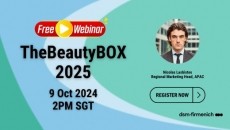L'Oréal's ‘Makeup Genius’ app sees success in China with 4.7 million downloads

The app first launched in 2014 in Paris and quickly expanded into Europe, the US and Asia where L'Oréal combined its knowledge of consumers and the science of colours with technologies for monitoring facial expressions - customizing the platform for each market as it went along.
It has since become a major hit in China partly because of the size of the country's internet population - 668 million people and because the virtual experience allows curious young women to express themselves with some of the brand’s heavier make-up, which is still uncommon in the country.
According to chief marketing officer for L'Oréal China, Asmita Dubey, passing down make-up advice or tips from mom to daughter doesn't exist in Chinese culture, so girls are enjoying trying out new looks through the virtual experience.
“Girls in China can be shy to apply make-up if they are at the counter or if they are going out with friends - they don't want to put on very dark lipstick, very dark eye shadow," adds Dubey.
Mobile apps: opportunity or risk for beauty brands?
With apps that center on beauty products now hitting consumers’ screens thick and fast, Cosmetics Design wonders if the swiftly evolving mobile space poses an opportunity for brands, or a risk.
The answer seems to be a bit of both: as digital’s huge potential for branding and retail means it continues to dominate the beauty agenda.
Some apps exist independent of brands, which can limit the control that beauty companies hold over their own products’ representation.
Take for example, ‘Stash’, which allows users to view recommendations for new products to try on the basis of their existing collection, while another - the ‘ThinkDirty’ mobile platform - warns consumers off products which it deems potentially unsafe.
The rise of such apps confirms the need for brands to stay on their toes in this quickly adapting digital retail and marketing space.













![[Getty Images]](/var/wrbm_gb_food_pharma/storage/images/_aliases/wrbm_tiny/publications/cosmetics/cosmeticsdesign-asia.com/china/latest-developments-in-china-s-booming-beauty-market3/17870827-1-eng-GB/Latest-developments-in-China-s-booming-beauty-market.jpg)






